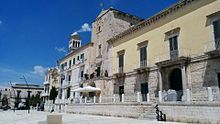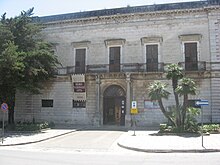Ruvo di Puglia
Ruvo di Puglia
Rìuve (Neapolitan) | |
|---|---|
| Comune di Ruvo di Puglia | |
 The cathedral | |
 Coat of arms | |
show Location of Ruvo di Puglia | |
 Ruvo di Puglia Location of Ruvo di Puglia in Italy | |
| Coordinates: 41°07′N 16°29′E / 41.117°N 16.483°E | |
| Country | Italy |
| Region | Apulia |
| Metropolitan city | Bari (BA) |
| Frazioni | Calendano |
| Government | |
| • Mayor | Pasquale Roberto Chieco |
| Area | |
| • Total | 221 km2 (85 sq mi) |
| Elevation | 240 m (790 ft) |
| Population (30 June 2017)[3] | |
| • Total | 25,366 |
| • Density | 110/km2 (300/sq mi) |
| Demonym(s) | Ruvesi |
| Time zone | UTC+1 (CET) |
| • Summer (DST) | UTC+2 (CEST) |
| Postal code | 70037 |
| Dialing code | 080 |
| Patron saint | Saint Blaise |
| Saint day | February 3 |
| Website | Official website |
Ruvo di Puglia (Italian: [ˈruːvo di ˈpuʎʎa]; Ruvese: Rìuve [ˈriːuvə]) is a town and comune in the Metropolitan City of Bari, Apulia, southern Italy, that is essentially devoted to agriculture, wine and olive growing. It is part of the Murge karst landscape.
Geography and territory[]
Ruvo's territory is known for its vineyards, olive groves and sowable fields, and is one of the largest in the province of Bari. Its wooded area is very interesting, with many downy oak trees (Quercus pubescens). Ruvo's territory consists of the Italian Alta Murgia National Park and shows typical elements of the Apulian karst landscape: sinkholes, karst valleys also known as "lame", among which are the upper course of and various caves. Two important caves are the "" (the deepest cave in the Apulia region), and the nearby "Abisso di Notarvincenzo" (the deepest in Ruvo). They are located near the wide and green Ferratella "Lama" (valley) which must be considered as the Gate of the National Park of Alta Murgia.
History[]

The most ancient archaeological findings from the area date to the 9th century BC, when the Peucetians were settled in the area. Evidence of their presence is documented through a series of remains, most notably the fresco found in the Tomb of the Dancers. The fresco, which depicts peucetian women dancing, is one of the most important archeological findings in Ruvo and is now exhibited in the Naples National Archeological Museum.
In the 3rd century BC, after peacefully succumbing to greek rule and falling under Athenian patronage, Ruvo flourished: the now polis engaged in commerce with the rest of Greater Greece, Greece and most of the Pre-Roman civilizations in italy and had power and strength to never be seen again. With the Greek demise, it naturally fell under Roman rule. Under the Roman Empire it was first a military stronghold and later a municipium, but during the Imperial times it started to lose power and importance. After the fall of the Western Roman Empire, it went under the Byzantines tutelage, then the Saracens and the Normans. Later Ruvo became part of the county of Conversano.
After the Aragonese and French dominations it was a fief of the Carafa family, until the abolition of feudalism in 1806.
Main sights[]


Ruvo's historic center is one of the most important historical centers in Apulia. During the course of history, it was destroyed three times. In Ruvo's Historic Center there are buildings and sites that hold historical and archeological importance, such as the Cathedral, the remains of Ruvo's Castle, Palazzo Caputi, Palazzo Spada, Palazzo and Museum Jatta, Palazzo Avitaja, the Redentore Church, the Purgatory Church, the Ipogeo under the Cathedral with remains of the Paleo-Christian church and Roman Tombs, the Clock Tower, the Dante Alighieri Park, the Matteotti Square, Cavour Street, Giovanni Jatta Street, the remains of the medieval defensive walls with the towers, Vittorio Veneto Street, Cathedral Street, Madonna of Calentano Church (in the countryside, in the hamlet of Calentano).

The Cathedral is a prime example of Apulian Romanesque architecture. The façade has three portals and numerous decorations, depicting Catholic symbols that traditionally belong to the Christian allegory, as well as griffins and other mythical figures. There are two rose windows. The interior has a nave and two aisles ending with a transept. Among the numerous works of art are a wooden statue and the reliquary of Saint Blaise, a fresco portraying the Madonna and Child with St. Sebastian, a panel of the Virgin of Constantinople and a noteworthy wooden cross. Under the church are the remains of the Palaeo-Christian church and Roman tombs.

The Jatta Museum is the only Italian museum to have a private family collection dating back to 1800. It conserves and exhibits to this day the vases, tools and remains excavated by the Jatta Family. The most notable item is the Vase of Talos, the most famous in the entire collection.

The Caves of San Cleto (in Italian: le Grotte di San Cleto), under the church of Purgatory, in the old town, historic center.
References[]
- ^ "Superficie di Comuni Province e Regioni italiane al 9 ottobre 2011". Istat. Retrieved 16 March 2019.
- ^ "Popolazione Residente al 1° Gennaio 2018". Istat. Retrieved 16 March 2019.
- ^ Population from ISTAT
External links[]
| Wikimedia Commons has media related to Ruvo di Puglia. |
- Official website (in Italian)
- Web page about the landscape of Ruvo (in Italian)
- Tourist Audio guide APP for smartphones (in Italian)
- Cities and towns in Apulia
- Municipalities of the Metropolitan City of Bari
- Ruvo di Puglia



